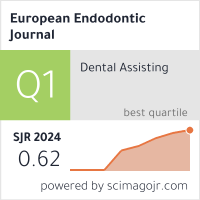Metrics
2024 IMPACT FACTOR
5 year Impact Factor
Eigenfactor Score
2024 CiteScore
Journal Citation Reports
(Clarivate 2025, JIF Rank)
Use of 2Shape® File in Adaptive Kinematics Influences Post-operative Pain After Single Visit Endodontics in Symptomatic Irreversible Pulpitis: A Double-blinded, Randomized Clinical Trial
Sayisree Yarlagadda, Keerthana Prabakar, Sooriaprakas Chandrasekaran, Velmugran Natanasabapathy, Nandini SureshDepartment of Conservative Dentistry and Endodontics, Meenakshi Academy of Higher Education and Research (Deemed to be University), Faculty of Dentistry, Tamil Nadu, IndiaObjective: This double-blinded randomized clinical trial aimed to compare postoperative pain using 2Shape® (TS) in rotary (TSRot) and adaptive (TSAK) kinematics in the maxillary and mandibular molars in patients with symptomatic irreversible pulpitis and symptomatic apical periodontitis following single-visit endodontic treatment.
Methods: Seventy patients were randomly assigned to two groups (TSRot /TSAK), (n=35 each). The preoperative and postoperative pain intensities at various time intervals up to 72h using a Visual-Analogue Scale was noted. Mann-Whitney U test (p<0.05*) was used to compare pain intensity, and the chi-square test was used to compare the incidence of pain. Dunns test (p<0.05*) was used for intragroup comparisons. Binary logistic regression was performed at consecutive time intervals.
Results: A total of 67 patients were included in the final analysis, and three were excluded due to medication intake. Both groups showed a gradual reduction in the mean incidence and intensity of postoperative pain from 6 to 72 hours. However, TSAK had a significantly lower intensity and incidence of pain than TSRot at 24h (p=0.02*). There was no statistically significant difference observed in the duration of instrumentation when the TS file was used in either adaptive or rotary kinematics (p=0.41).
Conclusion: Adaptive kinematics (TSAK) resulted in less pain incidence compared with rotary kinematics (TS-Rot). A statistically significant difference in incidence was observed at 24 h but may not be clinically significant. The duration of instrumentation was similar between the TSRot and TSAK groups. Thus, the 2Shape® (TS) file, which is a rotary file, can be used in adaptive kinematics to reduce the postoperative pain. (EEJ-2024-02-036)
Keywords: Motion kinematics, postoperative pain, root canal treatment, single-visit endodontics, twisted adaptive motion
Manuscript Language: English
(346 downloaded)



